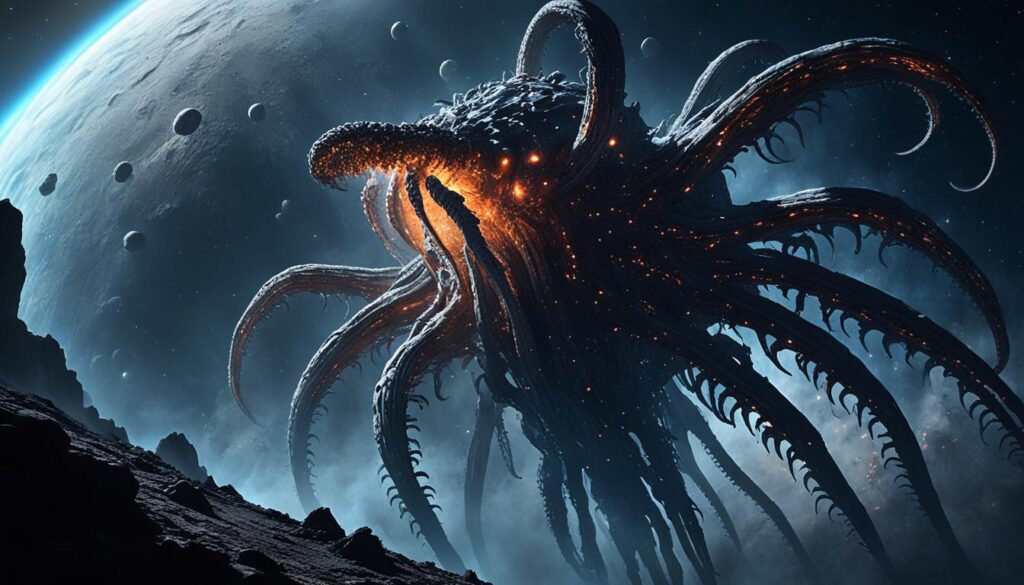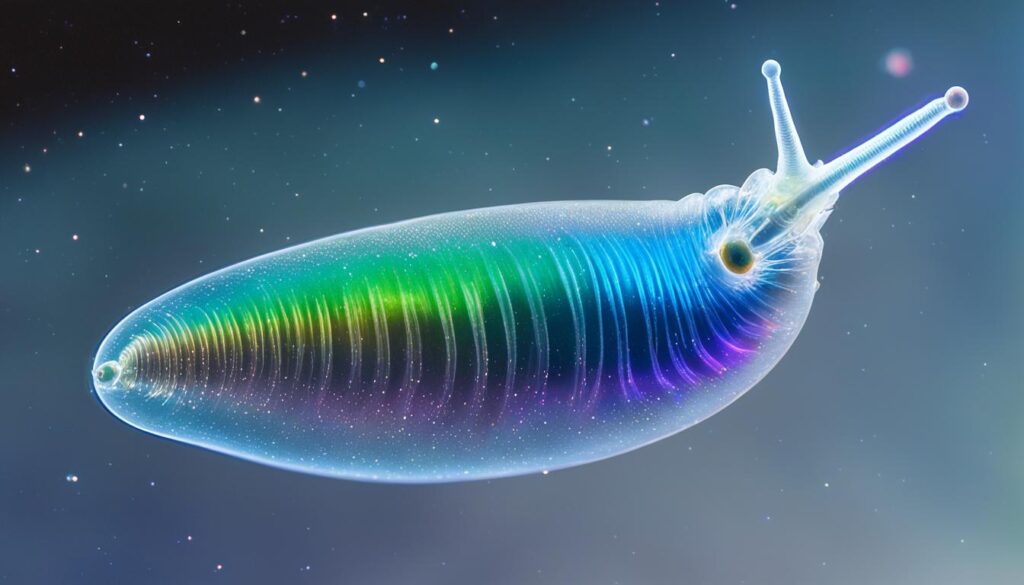Welcome to a cosmic adventure like no other! Prepare to journey into the depths of the galaxy and witness the wonder of the grooviest gastropods the universe has to offer. Get ready to meet alien snails, cosmic slugs, and extraterrestrial mollusks that will leave you in awe of their interstellar charm.
These celestial creatures, known as interstellar gastropods or space slugs, have carved out their unique niche in the vastness of outer space. Their presence in the cosmos has captured the imaginations of scientists and space enthusiasts alike, and once you learn about their funky adaptations and intergalactic habitats, you’ll understand why.
Key Takeaways:
- The galaxy is home to the grooviest gastropods, also known as space slugs or intergalactic snails.
- These extraterrestrial mollusks have unique adaptations and inhabit interstellar environments.
- Space slugs, such as the exogorth, are silicon-based giants that reside in the depths of asteroids.
- They reproduce through asexual fission and have a keen sense of spatial awareness.
- Space slugs have a fascinating history, from their potential use as superweapons to notable encounters with iconic spaceships.
The Enigmatic Exogorth: A Silicon-Based Giant
One of the most notable grooviest gastropods in the galaxy is the exogorth, also known as the space slug. These gigantic toothed gastropods are a unique species of silicon-based lifeforms that have adapted to survive in the harsh vacuum of space. They make their homes in the caverns and craters of asteroids, feeding on the minerals found within. The average adult exogorth grows to about 10 meters in length, although there have been reports of specimens reaching nearly a kilometer long.

The exogorth’s ability to thrive in such extreme conditions sets it apart from other space creatures. Its silicon-based biology allows it to withstand the rigors of space travel, making it an incredibly resilient species. This toothed gastropod has a uniquely designed mouth that allows it to latch onto asteroids and extract minerals for sustenance. The exogorth’s toothed tongue, known as the radula, is perfectly adapted for scraping and consuming rock-like substances.
Despite their massive size, exogorths have the ability to compress their bodies, allowing them to navigate through narrow passages and adapt to the confined spaces of asteroids. Their physical strength and agility make them formidable predators in their habitat. While their diet primarily consists of minerals, exogorths have been known to feast on space debris and unsuspecting space vessels that venture too close to their lairs.
Although the exogorth is a fascinating creature, its biology and behavior still hold many mysteries. Scientists continue to study these giant space slugs to unlock their secrets and gain a deeper understanding of the complex world of silicon-based lifeforms.
The Astounding Adaptations of the Exogorth
The exogorth’s unique adaptations enable it to survive in the harsh environment of space. Here are some of its most astounding features:
- Silicon-based biology: Unlike most lifeforms, which are carbon-based, exogorths are composed of silicon, allowing them to withstand extreme temperatures and conditions.
- Toothed gastropod: With its sharp teeth and specialized mouth, the exogorth can latch onto asteroids and extract minerals for sustenance.
- Compressible body: Despite its massive size, the exogorth can compress its body to navigate through narrow passages and fit into confined spaces.
- Predatory prowess: The exogorth’s physical strength and agility make it a formidable predator, capable of capturing both space debris and unsuspecting space vessels.
Asteroids: The Exogorth's Cosmic Abode
Asteroids serve as the primary habitat for exogorths. These rocky bodies provide the perfect shelter and abundant resources for their survival. Let’s take a closer look at how exogorths interact with asteroids:
| Asteroid Interactions | Role in Exogorth Ecology |
|---|---|
| Inhabitation | Exogorths make their homes in the caverns and craters of asteroids, utilizing the natural structures for protection and breeding. |
| Mineral Extraction | Exogorths extract minerals from the asteroid’s rocky surface, using their toothed mouths to scrape and consume the valuable resources. |
| Navigation | Exogorths navigate through the labyrinthine tunnels and passages of asteroids, utilizing their compressible bodies and spatial awareness. |
The Mysteries of Space Slug Biology
Space slugs, including the exogorth, have fascinating biological characteristics. They possess unique abilities and adaptations that contribute to their survival in the depths of space. Let’s explore some of these intriguing aspects.
Reproduction and Adaptability
Space slugs have a remarkable method of reproduction called fission. Through this process, an adult slug can split into two identical slugs, rapidly increasing their population and adapting to changing environments. This asexual reproduction allows them to thrive in the harsh conditions of outer space.
Growth and Molting
As space slugs grow, they undergo molting, shedding their old exoskeleton to make way for new growth. This process ensures their continued development and helps them maintain their flexibility and mobility in the zero-gravity environment.
Spatial Awareness
Space slugs possess a highly evolved sense of spatial awareness, enabling them to navigate their surroundings with precision. They can calculate the speed, trajectory, and distance of objects around them, allowing them to avoid collisions and potential dangers in their space habitats.
Diet and Consumption
Space slugs have an interesting diet that primarily consists of passive radiation, which they can absorb and convert into energy. However, they are also known to consume rocks, metal, and other space debris that come their way. This unique diet enables them to extract essential nutrients from their surroundings to sustain themselves in the vastness of space.
To summarize, space slugs possess fascinating biological traits, such as their ability to reproduce through fission, molting as they grow, advanced spatial awareness, and a diverse diet. These adaptations contribute to their success as intergalactic creatures, allowing them to thrive in the most unlikely of habitats.

Variations and History of Space Slugs
Space slugs, the grooviest gastropods in the galaxy, come in various forms and have a captivating history. Let’s explore the different variations and notable events surrounding these extraordinary creatures.
Giant Slug
The giant slug is a remarkable species known for its enormous size and formidable presence. Growing up to 30 meters in length, these colossal creatures roam the depths of space, leaving awe in their wake.
Crimson Slugs
Among the space slug species, crimson slugs stand out with their vibrant red stripes adorning their slimy bodies. These eye-catching slugs add a burst of color to the cosmic landscape, capturing the imagination of space travelers.
Cularin Slugs
The Cularin system is home to a unique breed of slugs, aptly named Cularin slugs. These slugs possess distinct characteristics that set them apart from their interstellar counterparts, making them a subject of scientific curiosity and admiration.
House of Adasca and the Great Sith War
“The House of Adasca, a powerful organization, discovered a way to manipulate and control the hunger drives, growth rate, and reproductive processes of space slugs during the Great Sith War. These celestial creatures became potential superweapons, adding a whole new layer of complexity to the conflict.”
Galactic War and the Minos Cluster
Throughout history, space slugs have made headlines, and one notable event occurred during the Galactic War. The Minos Cluster became the site of a significant discovery, as a hidden lair of space slugs was unearthed, revealing their mysterious habitats and shedding light on their unique behaviors and adaptations.
Hoth Asteroid Field and the Millennium Falcon
In one of the most legendary encounters, the Millennium Falcon, a famed starship, found itself hiding from its enemies within the treacherous Hoth asteroid field. Surprisingly, the ship sought refuge inside a massive space slug, narrowly escaping capture and adding to the lore of these cosmic creatures.
As you can see, space slugs have a rich history with variations that continue to intrigue and fascinate. From their massive size to their involvement in galactic conflicts, these grooviest gastropods leave an indelible mark on the annals of space exploration.
Conclusion
The grooviest gastropods in the galaxy, the interstellar and intergalactic snails known as space slugs, continue to captivate our imagination with their unique adaptations and extraterrestrial habitats. These celestial snails are a testament to the incredible diversity of life in the universe, showcasing the wonders that await us beyond our own planet.
From their enormous size to their silicon-based biology, space slugs serve as a reminder that life can thrive in even the most extreme environments. Their ability to survive and thrive in the vacuum of space is a remarkable feat of evolution, pushing the boundaries of what we thought was possible.
Whether we encounter them in the depths of an asteroid or witness their interactions with other species, the galaxys grooviest gastropods will always remain a source of wonder and fascination. The mysteries they hold and the discoveries they inspire serve as reminders of the vastness and complexity of the universe we inhabit.
FAQ
What makes space slugs so groovy?
Space slugs, also known as the galaxys grooviest gastropods, are truly out-of-this-world creatures. With their unique adaptations and interstellar habitats, they capture the imaginations of scientists and space enthusiasts. From their enormous size to their silicon-based biology, these cosmic slugs are a testament to the incredible diversity of life in the universe.
Where do space slugs live?
Space slugs, including the enigmatic exogorths, make their homes in the caverns and craters of asteroids. These intergalactic snails have adapted to survive in the harsh vacuum of space, feeding on the minerals found within asteroids. They are truly extraterrestrial mollusks.
How do space slugs reproduce?
Space slugs reproduce asexually through a process called fission. An adult slug splits into two identical slugs, allowing them to quickly populate their environments and adapt to changing conditions.
Do space slugs have any unique biological characteristics?
Yes, space slugs undergo molting as they grow and have a highly evolved sense of spatial awareness. This enables them to calculate the speed, trajectory, and distance of objects around them. They primarily feed on passive radiation but are also known to consume rocks, metal, and other space debris.
Are there different types of space slugs?
Yes, there are various types of space slugs. These include the giant slug, crimson slugs with red stripes, and the Cularin slugs found in the Cularin system. Throughout history, space slugs have made headlines, such as being potential superweapons during the Great Sith War and encounters with the Millennium Falcon hiding in a space slug in the Hoth asteroid field.